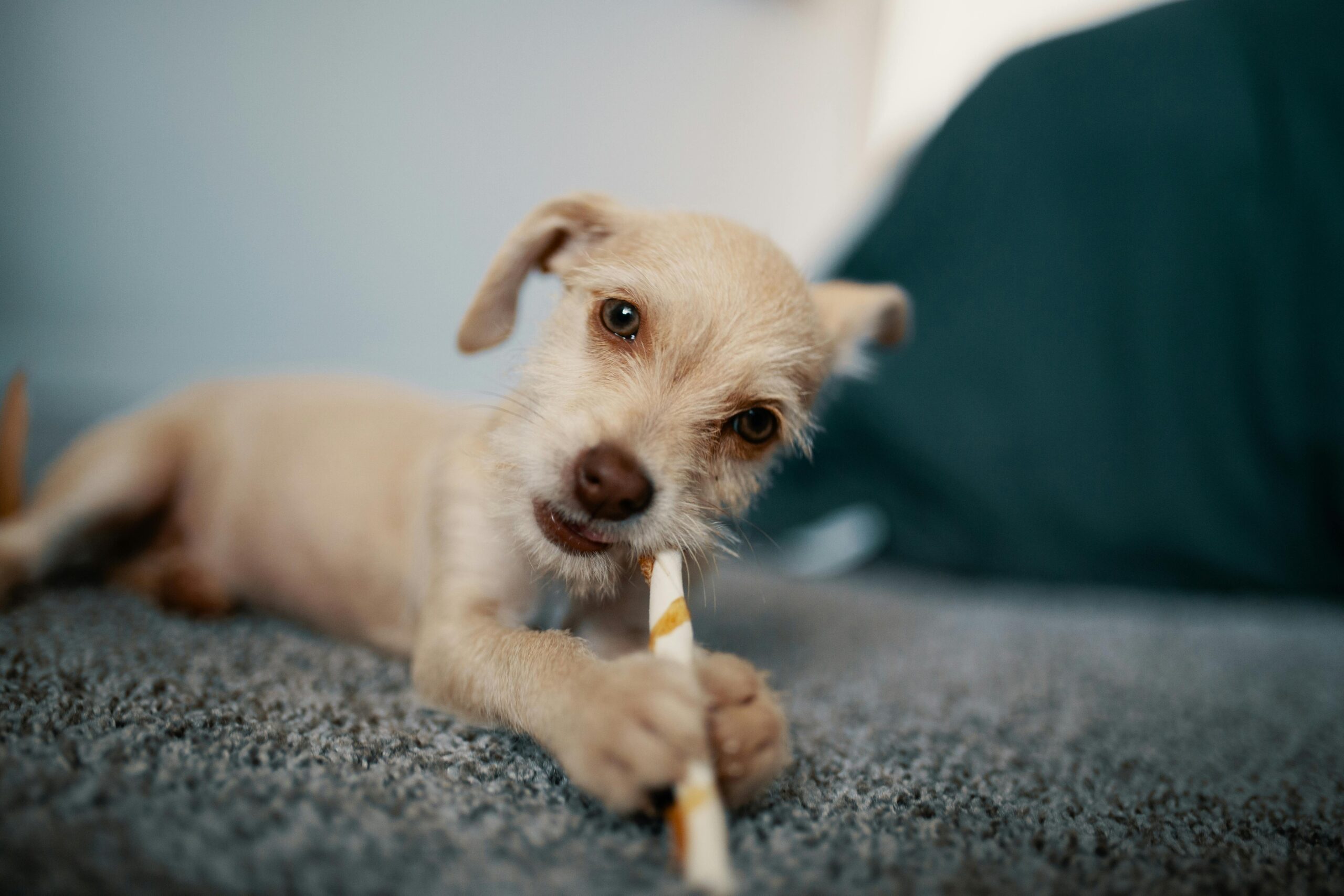Your cart is currently empty!

Why does my dog chew on everything?
We’ve Got a Problem to Chew On, and it is a common question we hear, “why does my dog chew on everything?”
I had been told the answer is, “It is just what dogs do.” but I am the girl who always asks why. Just imagine you’ve just walked into your living room to find your favorite pair of shoes… or at least what’s left of them. Frayed laces, gnawed-up leather, and your dog is looking at you with guilt and total satisfaction. Or maybe it’s the TV remote—chewed just enough to make you wonder if your Netflix binge is over for good. You’re frustrated, perhaps even a bit desperate, and wondering, “How do I stop my dog from chewing everything?!”

Common Causes of Chewing
Let’s face it: dogs have an uncanny knack for finding—and destroying—their owner’s most precious items. I’ll never forget the day I bought my dog, Penny, a fluffy, comfy bed for her kennel. I wanted her to be comfortable when she had to be in her crate. I left her alone for just ten minutes, and when I came back, there was a “snowstorm” of cotton fluff everywhere. Penny was proudly wagging her tail, surrounded by shredded bits of her brand-new bed. The look in her eyes said, “Look what I did! Aren’t you proud?” It was frustrating yet somehow endearing. I realized it wasn’t malice, just her natural curiosity—and maybe a bit of boredom.
Here are some common causes of chewing that can help you understand your dog’s behavior:
- Teething: Puppies chew as a natural part of teething, which helps soothe their gums and explore the world.
- Boredom: Chewing is often a sign that your dog isn’t getting enough mental stimulation or physical exercise. When they’re bored, dogs find creative ways to entertain themselves—sometimes at the expense of your shoes!
- Anxiety or Stress: Some dogs chew as a way to relieve stress or separation anxiety, especially if they’re alone for long periods.
- Lack of Appropriate Chew Toys: If your dog doesn’t have designated chew toys, they’ll improvise on whatever’s available, often targeting furniture, remotes, or other household items.
Check out our Etsy store to see our “I make fetch happen” gear.
Desired Behaviors
When addressing problem behaviors in dog training, we always have to ask the question, “What do I want my dog to do instead?” By redirecting your dog’s energy toward more positive activities, you’re setting them up for success. Here are a few alternatives to destructive chewing:
- Choosing and Chewing on Designated Dog Toys: Teaching your dog to stick to their own chew toys can help prevent furniture or shoe destruction.
- Lying Calmly Instead of Chewing on Household Items: Encouraging calm behavior can minimize problem chewing, especially if your dog tends to chew when stressed.
- Redirecting Energy to Positive Activities: Provide your dog with engaging tasks like fetching, using food puzzles, or playing a “find it” game with their toys.
Training Commands for Redirection
Using positive reinforcement dog training techniques, you can teach your dog commands to help prevent chewing on inappropriate items. Here are some key commands that can help your dog break the habit:
- “Leave It”: Teach your dog to ignore household items and wait for an alternative.
- “Go to Place”: Guide them to a specific area (like a mat or bed) where they can lie down with an approved toy.
- “Find Your Toy”: Encourage your dog to seek out and play with their own toys instead of chewing on off-limits objects.
Practice Progressions for Each Command
To make training commands effective, practice them in stages. Here are step-by-step progressions to help reinforce these positive behaviors:
- “Leave It”:
- Level 1: Hold a toy in one hand and a treat in the other. Say “leave it” and reward with the treat when your dog leaves the toy alone. Alternatively, say “leave it” and then give your dog a replacement chew item. During the puppy chewing phase, I went through almost a bone a night with Penny!
- Level 2: Place the toy or household object on the floor. Say “leave it,” and reinforce with a treat when your dog doesn’t go for it.
- Level 3: Increase the challenge by leaving objects out in different rooms. Say “leave it” as they approach, and reward them for ignoring it.
- “Go to Place”:
- Level 1: Guide your dog to a mat or bed, say “go to place,” and reward them when they stay there.
- Level 2: Practice having them stay on the mat longer before rewarding them.
- Level 3: Use “go to place” when they start to chew something off-limits. Reward only after they lie down and settle.
- “Find Your Toy”: This is a fun game and an effective way to redirect energy!
- Level 1: Show your dog their toy and say “find your toy,” rewarding them when they interact with it.
- Level 2: Hide the toy nearby, say “find your toy,” and praise them when they locate it.
- Level 3: Increase the difficulty by hiding the toy farther away so your dog learns to search for it on command.
Conclusion
Preventing destructive chewing in dogs is a journey of patience and consistency, but the results are worth it! Using positive reinforcement to redirect and reward appropriate behaviors, you’re giving your dog healthy outlets for chewing. With a little practice, your dog will learn to choose chew toys over shoes, leaving you both happier and your home intact.
By setting clear boundaries and engaging your dog’s mind, you’ll not only solve problem behaviors but also strengthen the bond you share. Remember, the goal isn’t just to stop the chewing—it’s to guide your dog toward positive choices that help them thrive.
